Sunday Dec 21, 2025
Sunday Dec 21, 2025
Wednesday, 5 December 2018 00:00 - - {{hitsCtrl.values.hits}}

Modern strategic planning is all about winning a highly competitive game whose rules can change almost overnight. It is all about having the courage to modify your business model and reinvent your organisation to sustain success under fast-changing conditions. 
This article offers a goal-based approach to strategic planning for boosting corporate performance within a framework of increasing business uncertainty. This requires evaluating the opportunities and risks arising from foreseeable changes, and then deciding what to do and what not to do. As Michael Porter summarised: “The essence of strategy is choosing what not to do.”
Need for strategic planning guidance
In spite of the uncertainty, complexity, and the ever-present possibility of failure, strategic planners must eventually decide what the action plans they recommend should and should not focus on. Choosing what not to do is easy under stable conditions by relating to past failures. However, under volatile conditions, different parts of a company often tend to focus on their own priorities and goals. These may no longer be aligned with an overarching, companywide strategy.
Terminating or putting on hold ongoing tasks that were enthusiastically initiated to reach earlier objectives can produce negative emotions and psychological resistance. Therefore, planning done in collaboration with representatives from the different business units is best guided by an unbiased and experienced external strategic planner.
Importance of focus
A company can quickly lose its focus when the pursuit of organic growth is delegated to department heads. They generally tend to look for quick and easy incremental opportunities such as finding new customer groups, adding sales channels, and building product line extensions. When each business unit chases growth independently, large companies end up by duplicating a lot of effort and investment as they struggle with an increasingly incoherent portfolio of businesses, product lines, and capabilities. 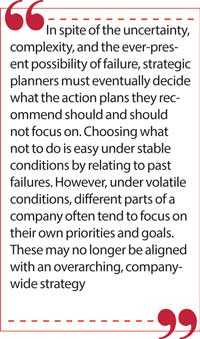
One of history’s greatest strategic thinkers, Napoleon Bonaparte, summed it up this way: “In order to concentrate superior strength in one place, economy of force must be exercised in other places.”
Strategic planning thus involves a process of integration and unification: boldly selecting the most promising opportunities to focus corporate resources such as people, effort, and money; choosing what opportunities to ignore; deciding what current tasks to terminate or put on hold; and realigning the corporate vision and mission statements with the chosen strategic direction. This approach ensures that day-to-day decisions that drive small tasks are aligned with the overall corporate direction.
This was what Henry Mintzberg meant when he said: “Strategy is a pattern in a stream of decisions.”
Overcoming reluctance to change
The biggest problem associated with strategic planning under uncertain conditions is a mental conflict technically called ‘cognitive dissonance’. This is the mental discomfort when presented with evidence that shows your current beliefs, attitudes and behaviours are no longer valid.
Rather than accepting the need for change as suggested by the evidence, most people would dismiss as untrue such information that points out the inaccuracy or futility of their current thinking and behaviours and then find ways to rationalise their decision to ignore the evidence.
As John Maynard Keynes summarised: “The difficulty lies not in finding new ideas, but in escaping from the old ones.”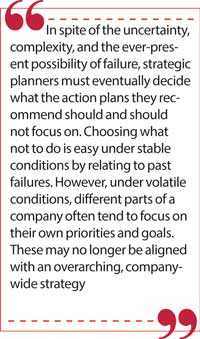
Therefore, any attempt to redefine the business model will be opposed by the limiting beliefs arising from current knowledge, skills, tools and processes that worked well in the past. The first inclination would be to justify existing corporate attitudes and behaviours rather than admitting that these are no longer valid. To eliminate such mental conflict, strategic planners need to address the underlying fear of the perceived risk of failing and losing even what you currently have by trying to make changes with no guarantee of success.
Failure of conventional approaches
The strategic planning process followed by most companies share three common characteristics: 1) wait until the annual strategy review to revisit strategy; 2) prepare a SWOT analysis as input to the start of the strategy process; and 3) start the strategy process with a lengthy exercise to rewrite the vision and mission statements to capture organisational aspirations. This familiar approach to strategic planning cannot deliver what organisations now need, due to the following reasons.
1) Instead of waiting for the annual review, strategies need to be quickly realigned with accelerating changes in economic conditions, customer expectations, competitor activity, technological innovations, etc.
2) A SWOT analysis is useful only after deciding strategically ‘where to play and how to win.’ Starting the planning process with a detailed SWOT analysis hinders creative thinking since there are no universal strengths, weaknesses, opportunities, or threats. Under different strategies adopted to reach corporate goals, strengths can become weaknesses and vice versa. For example, when Avis was struggling to compete with Hertz, the No. 1 brand in the car rental business, it positioned its weaker No. 2 market position as its strength: ‘We are #2. We try harder!’
3) The current vision and mission statements need to be reviewed and changed after new strategies are identified through the planning process to capture their essence.
Proactively embracing uncertainty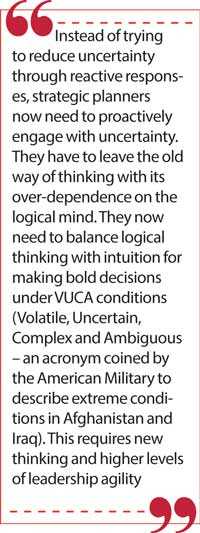
Instead of trying to reduce uncertainty through reactive responses, strategic planners now need to proactively engage with uncertainty. They have to leave the old way of thinking with its over-dependence on the logical mind. They now need to balance logical thinking with intuition for making bold decisions under VUCA conditions (Volatile, Uncertain, Complex and Ambiguous – an acronym coined by the American Military to describe extreme conditions in Afghanistan and Iraq).
This requires new thinking and higher levels of leadership agility. Strategic planning in a VUCA business world needs to balance analytical thinking with creative and intuitive insights. Developing this intangible skillset is what makes effective strategic planning a major problem in today’s organisations.
Using probabilistic thinking
Under today’s volatile conditions, strategic planning requires thinking in probabilities instead of absolutes. This is based on available information interpreted through logic and intuition, with a willingness to update the strategies whenever new information requires such change. Due to increasing business uncertainty, complexity, and the ever-present possibility of failure, strategic planning should be founded on probabilistic thinking about what an organisation should do to reach its goals and what appears to be the best way to do it.
This flexible approach to strategic planning produces learning organisations that can quickly adapt to today’s unpredictably fast-changing operating environments. This is comparable to heuristically designed adaptive control systems that can self-adapt to changes that may lie outside the originally forecasted limits.
Productivity vs. strategy
Productivity is about doing things right. Strategy is about doing the right things well, knowing that today’s right things may become tomorrow’s wrong things. It is clear that productivity targets instil discipline and accountability. But they don’t directly help the operating units grow organically under changing conditions.
Organisations cannot sustain high performance simply by following previously proven methods because past achievements could be the enemy of future success. Without a proper strategy, productivity cannot sustain corporate success in today’s business world.
As Peter Drucker said: “There is nothing quite so useless as doing efficiently that which should not be done at all.”
Top-down vs. bottom-up planning
There are some good reasons for delegating organic growth planning to the operating units. They are closer to the frontline and so are well positioned to spot opportunities and threats. Moreover, organic growth initiatives typically do not require new capital. However, if you leave corporate growth to the frontlines, they’ll tend to favour the projects they know they can do over the ones that represent the biggest opportunities. 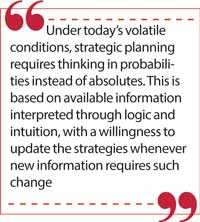
Managers would rather succeed conservatively than fail bravely. The best way to fight this tendency is to instil standards and practices that make transparent the scale and source of growth opportunities at the frontlines. The idea is to get unit managers to identify the highest-potential opportunities so that they will be less likely to propose investing in ‘safe’ areas that would yield only small wins.
Reviewing the business model
The same products, services or technologies can fail or succeed depending on the business model you choose. Exploring different possibilities is critical to finding a successful business model. Strategic planning must thus start with a zero-based approach that re-examines what business you are in – what products and services are you offering to what target groups where and why. The aim should be to answer the question ‘what business are you in?’ in the short time period of an elevator ride, usually 20-60 seconds (your ‘Elevator Pitch’).
Fighting the business cycle
In the boom part of the business cycle, many companies invest aggressively in growth; in the bust part, they turn cost-conscious and focus unduly on profitability. By amplifying the cycle in this way, companies can do great harm to their operating units’ organic growth efforts. During good times, managers justify adding unnecessary head count or pay too much for an asset they think they need. 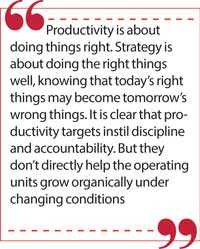
When the cycle inevitably turns downward, they have to scale down at a significant cost in time, money, and attention to growth. At the bottom of the cycle, pessimistic signals from the top can make unit managers reluctant to fund new products, upgrade critical aspects of customer service, or invest in market building. The damage from such inaction often takes longer to materialise, but the negative impact can be just as big.
Business model redesign
Due to conventional business typecasting, we often see operating units designated as ‘growth engines’ that get a lion’s share of investment capital, while others are considered ‘cash cows’ that fund the growth engines. The problem is that these labels shape beliefs about growth, affect the units’ behaviour and ultimately become self-defeating, especially under turbulent conditions.
Every business unit has the potential to create new benefits for current customers or to find new customers for the benefits it provides. If managers give up on organic growth due to the typecasting label attached to their unit, they won’t look as hard for the innovations and enhancements that will keep them ahead of the competition.
Strategic planners who understand business model redesign explore extremely different alternatives, rather than limiting themselves through conventional thinking. For example, they would consider investing for growth in hard times or steady growth during a boom. By removing wastage through lean concepts, and cutting unnecessary overhead, the savings can be ploughed back in the form of investments for organic growth during hard times.
As General Sun Tzu said 2,500 years ago in his masterwork on military strategy ‘The Art of War’: “During peace, prepare for war. During war, prepare for peace.”
Slogans that capture corporate strategy
In addition to formulating a distinctive roadmap for sustaining corporate success, strategic planning is also about translating it into simple words that everyone can understand and buy-into. This requires a clear message strategy that captures the essence of the strategic positioning of the company in terms of meeting customer expectations against competitive forces. When the future direction of the company is expressed clearly with well-chosen words that are simple and relevant, the potential for confusion is greatly reduced.
As George Orwell wrote: “The slovenliness of our language makes it easier to have foolish thoughts.”
Benefits of actionable slogans
When seeking new and coherent ways to grow the business, having a common slogan for thinking and talking about sustainable growth helps to clarify what is most important. The objective is to condense the company’s ‘Elevator Pitch’ into a simple, meaningful and actionable strategic slogan for internal audiences.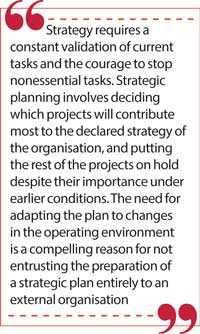
For example, I trained the entire workforce of a five-star luxury hotel in Colombo to improve their soft skills to deliver a memorable brand experience to every guest at every contact point. Having collected their ideas for sharpening the competitive edge of the hotel against increasing competition, I captured the new strategic direction of the Hotel with the internal slogan, ‘Love and Care’.
Love implied an emotional commitment to connect with every guest; Care implied a rational commitment to satisfy all their needs, irrespective of an employee’s position within the hotel. This simple slogan that everyone could understand became the practical benchmark for superior service delivery. As a result, their Guest Satisfaction Tracking Score shot up by a record-breaking 40.4% in just five months.
Another example of an actionable slogan that captures the essence of corporate focus on superior customer service is the Avis slogan: ‘We are #2. We try harder!’
Probabilistic strategic planning
Probabilistic goal-based strategic planning is essential for sustaining organisational success in today’s turbulent world. Its main focus should be consolidating present results while paving the way to create future successes under fast-changing conditions. It must be based on a deep and intuitive awareness of how the knowledge, skills, resources and processes found within your organisation can be leveraged to sustain success under future scenarios.
As Phil Rosenzweig summarised: “Companies cannot achieve superior and lasting business performance simply by following a specific set of steps.”
Facilitating strategic planning
Strategy thus requires a constant validation of current tasks and the courage to stop nonessential tasks. Strategic planning involves deciding which projects will contribute most to the declared strategy of the organisation, and putting the rest of the projects on hold despite their importance under earlier conditions.
The need for adapting the plan to changes in the operating environment is a compelling reason for not entrusting the preparation of a strategic plan entirely to an external organisation.
Our proven methodology
We use a ‘home-grown’ approach to strategic planning by deploying your in-house expertise focused through our experience in developing sustainable business strategies. This includes process reengineering for minimising operating costs and maximising service delivery. The end result is a practical Strategic and Activity Plan that will include overall goals and objectives broken down into quarterly milestones with responsibilities, outcomes, timelines and budgets for each task.
A major benefit of our participative strategic planning process is the ability of your planning team to adapt the Plan to fast changing operating conditions. They would be fully aware of the thinking process that produced the Plan and would be able to make necessary adjustments whenever needed.
Strategic planning to action planning
There is a well-known anecdotal business statistic that 90% of organisations fail to execute their strategies. The goal of strategic planning should be action planning. However, the market and operating conditions will not remain the same as when the action plan was prepared.
Therefore, action plans have to be frequently reviewed and suitably modified based on market fluctuations, technological trends, competitor actions, cost/benefit analyses, etc. Our approach to strategic planning is founded on the underlying concept of business uncertainty.
(Dr. Asoka Jinadasa is a UK Chartered Engineer with a US PhD in Business Strategy. He has won four global awards for consulting and human capital development, and made keynote speeches and presentations at 15 international conferences in seven countries. He founded the Intrinsic Leadership Academy with UK-trained Lean Six-Sigma expert Arosha Jayasundera. He can be contacted through [email protected] or their website: www.intrinleaders.com.)